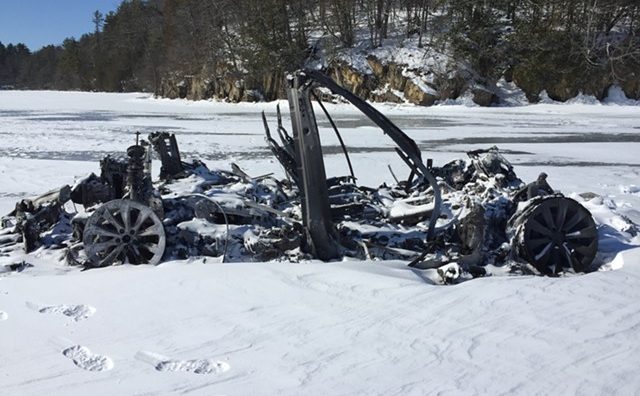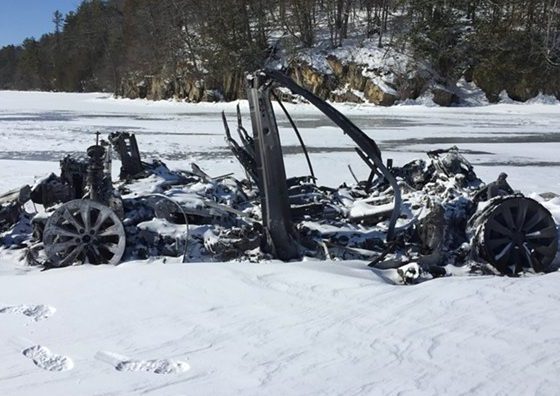

News
Tesla Model X frozen lake mystery gets solved, and the truth is stranger than fiction
Back in 2019, a picture of a charred Tesla Model X in the middle of a frozen lake in Vermont resulted in a lot of electric vehicle enthusiasts scratching their heads in confusion. Very few details were made public, though the police noted back then that the owner of the vehicle drove the Model X to the lake, where it supposedly struck a rock and caught fire.
The incident was pretty strange, partly because the car fully burned up without melting the ice and falling into the frozen lake. Little information was also available about the owner of the vehicle, though it was reported that no one was injured in the incident. Recently, the mysteries surrounding this peculiar Model X fire were explained, and by the Department of Justice, no less. Needless to say, the truth in this particular Model X fire was stranger than fiction.
According to the US Attorney’s Office in Vermont, the Model X was actually part of a pretty expansive scam executed by 32-year-old Michael A. Gonzalez of Colchester, Vermont. The scam involved Gonzalez acquiring Teslas by exploiting a procedure adopted by the company that allowed him to take deliveries of vehicles before his bank transfer was fully cleared.
As per a report from Seven Days, Gonzalez’s breakthrough came in September 2018, when he reserved a Tesla Model 3 that cost $58,200. To acquire the vehicle, the scammer paid Tesla a $2,500 downpayment and set up an automated payment scheme to draft the vehicle’s monthly payments. Tesla delivered the Model 3, and days later, Gonzalez’s fund transfers were rejected by the bank. The vehicle was taken around December 2018 to a used car dealership, where Gonzalez sold it for $42,500.
Fresh from his successful scam, Gonzalez decided to go for a bigger prize next: a Tesla Model X. Using the same playbook, he was able to acquire a Model X worth $144,200. Tesla delivered the vehicle, and weeks later, Gonzalez was able to sell the all-electric SUV through Craigslist for $90,000.
According to investigators, the Model X that ended up on the frozen lake was actually the third Tesla in Gonzalez’s scheme. It was a vehicle worth $152,663, the scammer’s most expensive yet. But while he was able to pick up the car in Tampa, Tesla did not provide Gonzalez with the ownership paperwork needed to register or resell the car. In response to this, Gonzalez reportedly took the car to a frozen section of Shelburne Bay, where it was later found in flames.
The gutsy Gonzalez actually filed an insurance claim for the Model X’s loss, but he never showed up for a required examination under oath where he was required to bring the electric vehicle’s certificate of ownership. Ultimately, the claim was denied.
Not to be discouraged, Gonzalez went for a fourth Tesla in March 2019, another Model X for $136,710. This time around, he used another person’s driver’s license and another address. Tesla delivered the vehicle, and it was registered with the Vermont DMV. Gonzalez then transferred the Model X’s title under his own name, claiming that he had acquired it through an “even trade” with an $8,200 2013 Kia Optima. The Model X was sold on eBay for $99,400.
Unfortunately for Gonzalez, his streak ended when he initiated his scam for the fifth time in July 2019. Tesla eventually hired a repossession company, and the vehicle was tracked to a Burlington garage. The scammer fled, though he was later arrested in February 2020 on a separate gun charge. Upon his release, he had the Tesla towed from a storage facility for what he believed was another sale. The Seabrook Police Department was not having it by this time, and they proceeded to impound the Model X.
As per the US Department of Justice, Gonzalez is currently being charged with five counts of possessing and selling stolen motor vehicles. He is ordered detained by United States Magistrate Judge Kevin J. Doyle pending a detention hearing next week, and he is at risk of facing ten years in prison for each count of possessing and selling stolen cars.
Don’t hesitate to contact us with account tips. Just send a message to tips@teslarati.com to give us a heads up.

News
Tesla FSD fleet is nearing 7 billion total miles, including 2.5 billion city miles
As can be seen on Tesla’s official FSD webpage, vehicles equipped with the system have now navigated over 6.99 billion miles.

Tesla’s Full Self-Driving (Supervised) fleet is closing in on almost 7 billion total miles driven, as per data posted by the company on its official FSD webpage.
These figures hint at the massive scale of data fueling Tesla’s rapid FSD improvements, which have been quite notable as of late.
FSD mileage milestones
As can be seen on Tesla’s official FSD webpage, vehicles equipped with the system have now navigated over 6.99 billion miles. Tesla owner and avid FSD tester Whole Mars Catalog also shared a screenshot indicating that from the nearly 7 billion miles traveled by the FSD fleet, more than 2.5 billion miles were driven inside cities.
City miles are particularly valuable for complex urban scenarios like unprotected turns, pedestrian interactions, and traffic lights. This is also the difference-maker for FSD, as only complex solutions, such as Waymo’s self-driving taxis, operate similarly on inner-city streets. And even then, incidents such as the San Francisco blackouts have proven challenging for sensor-rich vehicles like Waymos.
Tesla’s data edge
Tesla has a number of advantages in the autonomous vehicle sector, one of which is the size of its fleet and the number of vehicles training FSD on real-world roads. Tesla’s nearly 7 billion FSD miles then allow the company to roll out updates that make its vehicles behave like they are being driven by experienced drivers, even if they are operating on their own.
So notable are Tesla’s improvements to FSD that NVIDIA Director of Robotics Jim Fan, after experiencing FSD v14, noted that the system is the first AI that passes what he described as a “Physical Turing Test.”
“Despite knowing exactly how robot learning works, I still find it magical watching the steering wheel turn by itself. First it feels surreal, next it becomes routine. Then, like the smartphone, taking it away actively hurts. This is how humanity gets rewired and glued to god-like technologies,” Fan wrote in a post on X.
News
Tesla starts showing how FSD will change lives in Europe
Local officials tested the system on narrow country roads and were impressed by FSD’s smooth, human-like driving, with some calling the service a game-changer for everyday life in areas that are far from urban centers.

Tesla has launched Europe’s first public shuttle service using Full Self-Driving (Supervised) in the rural Eifelkreis Bitburg-Prüm region of Germany, demonstrating how the technology can restore independence and mobility for people who struggle with limited transport options.
Local officials tested the system on narrow country roads and were impressed by FSD’s smooth, human-like driving, with some calling the service a game-changer for everyday life in areas that are far from urban centers.
Officials see real impact on rural residents
Arzfeld Mayor Johannes Kuhl and District Administrator Andreas Kruppert personally tested the Tesla shuttle service. This allowed them to see just how well FSD navigated winding lanes and rural roads confidently. Kruppert said, “Autonomous driving sounds like science fiction to many, but we simply see here that it works totally well in rural regions too.” Kuhl, for his part, also noted that FSD “feels like a very experienced driver.”
The pilot complements the area’s “Citizen Bus” program, which provides on-demand rides for elderly residents who can no longer drive themselves. Tesla Europe shared a video of a demonstration of the service, highlighting how FSD gives people their freedom back, even in places where public transport is not as prevalent.
What the Ministry for Economic Affairs and Transport says
Rhineland-Palatinate’s Minister Daniela Schmitt supported the project, praising the collaboration that made this “first of its kind in Europe” possible. As per the ministry, the rural rollout for the service shows FSD’s potential beyond major cities, and it delivers tangible benefits like grocery runs, doctor visits, and social connections for isolated residents.
“Reliable and flexible mobility is especially vital in rural areas. With the launch of a shuttle service using self-driving vehicles (FSD supervised) by Tesla in the Eifelkreis Bitburg-Prüm, an innovative pilot project is now getting underway that complements local community bus services. It is the first project of its kind in Europe.
“The result is a real gain for rural mobility: greater accessibility, more flexibility and tangible benefits for everyday life. A strong signal for innovation, cooperation and future-oriented mobility beyond urban centers,” the ministry wrote in a LinkedIn post.
News
Tesla China quietly posts Robotaxi-related job listing
Tesla China is currently seeking a Low Voltage Electrical Engineer to work on circuit board design for the company’s autonomous vehicles.

Tesla has posted a new job listing in Shanghai explicitly tied to its Robotaxi program, fueling speculation that the company is preparing to launch its dedicated autonomous ride-hailing service in China.
As noted in the listing, Tesla China is currently seeking a Low Voltage Electrical Engineer to work on circuit board design for the company’s autonomous vehicles.
Robotaxi-specific role
The listing, which was shared on social media platform X by industry watcher @tslaming, suggested that Tesla China is looking to fill the role urgently. The job listing itself specifically mentions that the person hired for the role will be working on the Low Voltage Hardware team, which would design the circuit boards that would serve as the nervous system of the Robotaxi.
Key tasks for the role, as indicated in the job listing, include collaboration with PCB layout, firmware, mechanical, program management, and validation teams, among other responsibilities. The role is based in Shanghai.
China Robotaxi launch
China represents a massive potential market for robotaxis, with its dense urban centers and supportive policies in select cities. Tesla has limited permission to roll out FSD in the country, though despite this, its vehicles have been hailed as among the best in the market when it comes to autonomous features. So far, at least, it appears that China supports Tesla’s FSD and Robotaxi rollout.
This was hinted at in November, when Tesla brought the Cybercab to the 8th China International Import Expo (CIIE) in Shanghai, marking the first time that the autonomous two-seater was brought to the Asia-Pacific region. The vehicle, despite not having a release date in China, received a significant amount of interest among the event’s attendees.








